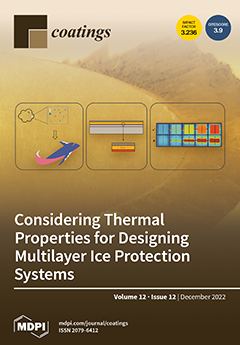Coatings, Volume 12, Issue 12 (December 2022) – 201 articles
Ice protection systems based on heating elements are common in structures exposed to icing weather, such as wind turbines or airplanes. Although the basis of their operation is well known, they are often neglected in the design stages of those devices, especially when integrated in a multilayered system with several other functions, causing huge efficiency losses or unsatisfactory performances.
The difficulty of assessing the amount of energy needed to homogeneously heat the surface of a structure, through multiple materials and under real operating conditions (especially in the case of an aircraft), shows the need for models and simulated environment tests as tools to develop and optimize those devices. View this paper
- Issues are regarded as officially published after their release is announced to the table of contents alert mailing list.
- You may sign up for e-mail alerts to receive table of contents of newly released issues.
- PDF is the official format for papers published in both, html and pdf forms. To view the papers in pdf format, click on the "PDF Full-text" link, and use the free Adobe Reader to open them.





